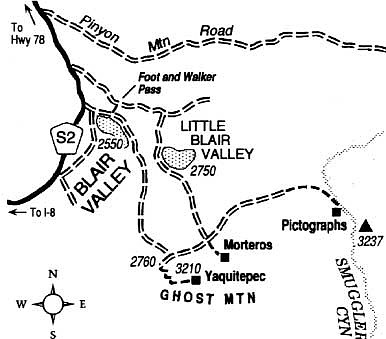 Facebook
Facebook
 X
X
 Instagram
Instagram
 TikTok
TikTok
 Youtube
Youtube
As September grades into October and the sun swings ever lower across the southern sky, the high-desert landscape around Anza-Borrego's Blair Valley becomes comfortable enough for an early-season visit. It's warm, dry, and desolate out there, and virtually abandoned, but that's part of its appeal. Don't forget to bring along plenty of water, especially at this "early" time of year.
The greater Blair Valley area is one of Anza-Borrego's more popular "primitive" camping areas -- those with few or no sanitary facilities but with plenty of open space and an almost infinite number of rocks and bushes. Roads (suitable for all but low-slung cars if driven carefully) and trails radiate out to a number of interesting historic or prehistoric points of interest.
One historic example is Foot and Walker Pass, the spot where passengers on the Butterfield Stage (1858-61) had to walk and sometimes help push their coaches over the low, rocky gap between Blair Valley and the next valley north -- Earthquake Valley.
The 60-year-old ruins of Yaquitepec, the hideaway of the eccentric and resourceful recluse Marshal South and his family for more than a decade, stand atop Ghost Mountain, easily reached by way of a mile-long hiking trail. The Souths raised three children in a manner that emulated the life of the prehistoric Indians. When not consumed with the business of survival, Marshal South wrote magazine articles detailing the family's experiences on what was then an extremely remote mountain top.
Bedrock morteros (Indian grinding holes) can be found at a marked, easy-to-reach site nearby. Note how several of the larger boulders there are pocked with dozens of shallow depressions -- called cupules. They were associated with fertility ceremonies and puberty rites.
At the pictograph site, reached by a well-worn 0.8-mile trail, Kumeyaay Indians left red and yellow painted designs on the face of a large boulder on the wall of Smuggler Canyon. Generations of archaeologists have puzzled over the meaning of these and other pictographs and petroglyphs (etched designs) that appear not only in the Anza-Borrego region but throughout the Southwest. These often-viewed pictographs have apparently been vivified in recent years by some kind of artistic makeover.
From the pictograph site, you may opt to continue hiking southeast down the wide Smuggler Canyon for another 0.4 mile to the top of a dry waterfall. The gap in the canyon there frames a view of Vallecito Valley to the south. Climb the knoll east of there (peak 3237) for a more inclusive view.


As September grades into October and the sun swings ever lower across the southern sky, the high-desert landscape around Anza-Borrego's Blair Valley becomes comfortable enough for an early-season visit. It's warm, dry, and desolate out there, and virtually abandoned, but that's part of its appeal. Don't forget to bring along plenty of water, especially at this "early" time of year.
The greater Blair Valley area is one of Anza-Borrego's more popular "primitive" camping areas -- those with few or no sanitary facilities but with plenty of open space and an almost infinite number of rocks and bushes. Roads (suitable for all but low-slung cars if driven carefully) and trails radiate out to a number of interesting historic or prehistoric points of interest.
One historic example is Foot and Walker Pass, the spot where passengers on the Butterfield Stage (1858-61) had to walk and sometimes help push their coaches over the low, rocky gap between Blair Valley and the next valley north -- Earthquake Valley.
The 60-year-old ruins of Yaquitepec, the hideaway of the eccentric and resourceful recluse Marshal South and his family for more than a decade, stand atop Ghost Mountain, easily reached by way of a mile-long hiking trail. The Souths raised three children in a manner that emulated the life of the prehistoric Indians. When not consumed with the business of survival, Marshal South wrote magazine articles detailing the family's experiences on what was then an extremely remote mountain top.
Bedrock morteros (Indian grinding holes) can be found at a marked, easy-to-reach site nearby. Note how several of the larger boulders there are pocked with dozens of shallow depressions -- called cupules. They were associated with fertility ceremonies and puberty rites.
At the pictograph site, reached by a well-worn 0.8-mile trail, Kumeyaay Indians left red and yellow painted designs on the face of a large boulder on the wall of Smuggler Canyon. Generations of archaeologists have puzzled over the meaning of these and other pictographs and petroglyphs (etched designs) that appear not only in the Anza-Borrego region but throughout the Southwest. These often-viewed pictographs have apparently been vivified in recent years by some kind of artistic makeover.
From the pictograph site, you may opt to continue hiking southeast down the wide Smuggler Canyon for another 0.4 mile to the top of a dry waterfall. The gap in the canyon there frames a view of Vallecito Valley to the south. Climb the knoll east of there (peak 3237) for a more inclusive view.
